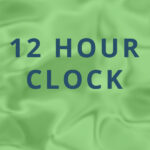The 12-hour clock is a timekeeping system traditionally used in many countries around the world. It divides the day into two 12-hour periods, designated as A. M. (which stands for “ante meridiem” or before midday) and P. M. (which stands for “post meridiem” or after midday). While many parts of the world have adopted more modern 24-hour clocks, the 12-hour clock remains one of the most widely used timekeeping systems today. This article will explore the origins of the 12-hour clock, how it works, and its advantages and disadvantages.
Real-Time 12 Hour Clock
The current time is:
What is 12 hour Time Called?
12-hour time is generally referred to as standard time, regular time, or AM/PM time. Standard time, regular time, and AM/PM time are all ways of telling time in a similar fashion. Standard time is the official measurement of the day, split into 24 hours. It is based on the solar day, which is the length of time it takes for one full rotation of the Earth. Regular time is based on 12-hour cycles and divides the day into two halves: morning and afternoon.
Benefits of the 12 Hour Clock
The 12-hour clock is an invaluable tool in many aspects of life. It allows us to easily keep track of time and plan our days accordingly. This system helps individuals and businesses alike stay organized, as it is easily divisible into two 12-hour periods: day and night. Additionally, it is more intuitive than the 24-hour clock, which often requires mental math or reference tables to calculate exact times. For those who do not possess a natural aptitude for mathematics, the 12-hour clock serves as a useful way of tracking their schedules without having to worry about making mistakes. Furthermore, using this clock has been found to improve physical performance, as studies have shown that athletes are able to better control their body’s energy levels when they divide their day into two distinct halves. Finally, the 12-hour clock proves beneficial for people with circadian rhythm disturbances who find traditional 24-hour clocks confusing because they can use the more straightforward layout of the 12 hours to stick to a regular sleep schedule.
Disadvantages of Using the 12-Hour Clock
The 12-hour clock system is a widely used way of measuring and expressing time, however, it does have its disadvantages. Firstly, the use of am and pm can be confusing as it can be unclear whether the morning or afternoon is being referred to. For example, if someone says they will meet at 8 pm, one may assume this is in the evening when in fact it could be 8 am. Secondly, when using the 12-hour clock system there are two ways you can express the same time - for example, 4:00pm can also be expressed as 16:00. This can lead to confusion for people who aren’t used to this system. Finally, daylight savings times can affect the accuracy of the 12-hour clock system as times need to be adjusted for certain parts of the year. Although it is widely used and accepted, these disadvantages must still be considered when using this type of clock system.
Who Invented 12-hour Clock?
The 12-hour clock was invented in the early 1300s by the dwfwItalian mathematician, astronomer, and physician, Giovanni de Dondi. He's most well known for his astronomical clock, the Astrarium, which he created around 1364. This clock was a masterpiece of mechanical engineering and had many features including a complex system of gears and weights to accurately display the time of day. It also included a calendar with movable numbers to show the years and months, as well as zodiac symbols. Dondi's invention of the 12-hour clock allowed for more accurate timekeeping than ever before, since it divided each day into two 12-hour periods instead of relying on sundials or water clocks. This new invention revolutionized how people kept track of time and is still in use today.
How to Read, Write and Tell Time with the 12-Hour Clock
Reading and telling time with the 12-hour clock is a skill that everyone should know. To begin, you will need to be familiar with the two numbers at the top of a standard clock face: 12 and 6. These numbers represent noon (12) and midnight (6). The other numbers in between (1-11) represent the hours in between. Each hour is divided into 60 minutes, using five-minute intervals marked by four lines on the dial. To read and tell time with a 12-hour clock, start by finding the hour number that corresponds to the long hand of your clock. Then, count how many five-minute intervals are between it and the shorthand to determine the minutes. For example, if your long hand is pointing just past 5 and your short hand is pointing to 4, then it would be 5:20.
12 Hour Clock and 24 Hour Clock
The 12-hour clock and the 24-hour clock are two different ways of representing time. The 12-hour clock is used in most countries for day-to-day activities, such as going to school or work. It uses two cycles of 12 hours each, starting at midnight and ending at 11:59 PM. In contrast, the 24-hour clock is used mainly by military personnel and in aviation. It starts at midnight (00:00) and goes up to 23:59. It can also be broken down into four 6-hour periods (0000-0559, 0600-1159, 1200-1759, 1800-2359), making it easier for some people to read. Both clocks have their advantages and disadvantages; however, the 12-hour clock is more widely used in everyday life due to its familiarity.
